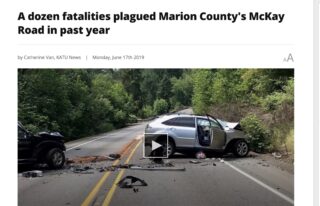
A bill that has received unanimous support from the Oregon House and Senate will give counties throughout Oregon a new tool to improve safety on rural roads.
House Bill 3213 creates a pilot program that will allow five counties to designate a dangerous stretch of road as a “safety corridor”. The legislation is meant to stem the tide of serious and fatal crashes that plague rural roads throughout the state. During committee hearings for the bill, lawmakers heard that many of Oregon’s once quiet farming roads now see increased levels of driving due to population growth and people who want to avoid congested interstates.
Some of these rural, county-owned roads also happen to be popular for bicycle riding.
“While Oregon backroads are some of the most beautiful drives in Oregon, they can be some of the most dangerous.”
— Shelly Boshart Davis, state rep who sponsored the bill
The first I heard of this bill came in a story published yesterday by KATU about McKay Road, south of Champoeg State Park in the Willamette Valley. The headline, “A dozen fatalities plagued Marion County’s McKay Road in past year,” caught my eye. I’ve ridden on McKay Road and it crosses the Willamette Valley Scenic Bikeway route.
Dennis and Sylvia Melcher are farmers who’ve lived in St. Paul near McKay Road for 60 years. “We have witnessed this road being transformed from a country road to a major highway thoroughfare,” they wrote in committee testimony, “Drivers are traveling on this road at 70 MPH or faster!”
Advertisement
The bill’s chief sponsor was State Representative Shelly Boshart Davis, a Republican who represents the rural farming district around Albany south of Salem. In a letter of support for her bill, Boshart Davis wrote, “While Oregon backroads are some of the most beautiful drives in Oregon, they can be some of the most dangerous… Law enforcement and county governments around the state are looking for ways to make these roads safer… By allowing county governments the power to bring awareness of the dangers of backroad driving, we give them another tool in their toolbox to save lives.”
The county version will be modeled after the existing program already in place at the Oregon Department of Transportation. Once a safety corridor is identified (must be 2 to 10 miles long and have a documented history of serious and fatal crashes), the transportation department can install caution signage and fines for traffic violations are doubled.
The bill also calls for the establishment of an advisory committee made of up county representatives. While this new program would be modeled after ODOT’s existing program, it’s likely to give county governments more flexibility to address safety concerns.
I asked a Multnomah County if they were aware of the bill and/or if they had any plans to take part in the program. Spokesman Mike Pullen said they haven’t identified any safety corridors as of yet, but they recognize it could be another tool to address safety.
This is an interesting development. I’ve personally been dreaming of a “bicycle safety corridor” designation for a few years now that would be modeled on the same program. Along with increased fines and caution signage, I’d like the designation to come with things like a “move over” passing law when a bicycle rider is present, implementation of bicycle turnouts, a speed limit reduction, and so on. Perhaps next session!
Learn more about HB 3213 here.
— Jonathan Maus: (503) 706-8804, @jonathan_maus on Twitter and jonathan@bikeportland.org
Never miss a story. Sign-up for the daily BP Headlines email.
BikePortland needs your support.

